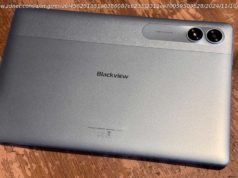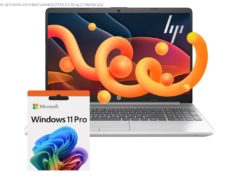Hands-on with Fitbit’s latest smartwatch for women (and men); smaller than the Ionic.
Fitbit’s latest activity tracker and health smartwatch, the Versa, is aimed at women but just as suitable for men, and looks rather like the 38mm Apple Watch.
We’re big fans of Fitbit’s first proper smartwatch activity tracker – the Ionic – as you’ll read on our Fitbit Ionic review. But one of the criticisms levelled at the Ionic was its size – deemed by some as too large for smaller (that is, female) wrists.
Without wanting to stereotype the sexes, women generally have smaller wrists than men – and I speak as a man with rather thin wrists. The new Fitbit Versa (short for „versatile“) is aimed at women, with a smaller and lighter watch body plus specific female-health tracking features. It’s less boxy than the Ionic, and more like a standard smartwatch in looks. Apparently, at the moment over 60 percent of smartwatch owners are male, and Fitbit sees an opportunity to grow this market for women.
That said, it will also suit men who prefer a smaller watch case than the Ionic’s larger, angular design. Its screen is certainly large enough for easy stats display and the interactive workout sessions through Fitbit Coach.
It’s also £100 or US$100 cheaper than the rather costly Ionic but boasts most of the same features, minus the built-in GPS on all models (and Fitbit Pay in the US) on the standard model. It effectively replaces the old Fitbit Blaze fitness watch, which is now discontinued. Read on for our comparisons of the Versa vs Ionic, Blaze and Apple Watch.
The Fitbit Versa is aimed at a wide range of people, from the casual walker to the more devoted runner, cyclist, swimmer or serious gym goer. It’s not just focused on fitness but on other gentler (but no less important) aspects of our overall health, too – from calmness and sleep to more detailed female health tracking features.
There are smart features, too, although nothing like what you get from the likes of the Apple Watch or Android smartwatches. This won’t bother people for whom health and fitness are the main goals, and Fitbit beats the other smartwatches hands down on these aims.
On-wrist notifications are great, and the Versa sees the release of customisable Quick Replies (see below).
For more help on the whole range, read our product guide on finding the best Fitbit for you to buy .
The Fitbit Versa is available now from the Fitbit Store .
The standard models cost £199.99 (US$199.95, €199.95), with a Special Edition priced at £229.99 (US$229.95, €229.95). The Special Edition comes with a woven strap (and for US buyers who lack this on the standard model, includes contactless payments via Fitbit Pay).
UK: Buy the Fitbit Versa now here
US: Buy the Fitbit Versa now here
This puts the Versa firmly in the upper-mid-price of the Fitbit range – nicely below the Ionic (£299/$299/€349), but some way above the less-smart Fitbit Charge 2 (£139/$149/€159). It also makes the Versa some way cheaper than the entry-level Apple Watch and some other smartwatches that do however boast a larger choice of apps.
There is the usual array of accessory straps, in extra silicon colours, leather and metal; see below for more details.
Versa is also be available in stores worldwide beginning April 2018, including Argos, Amazon, John Lewis, Currys PC World in the UK, and in North American retailers such as Amazon.com, Best Buy, Kohl’s, Macy’s, Target, and Walmart .
The Fitbit Versa is noticeably smaller than the Ionic, which (while thin) is quite large for a watch. Its screen size is 34mm diagonal, by 24.075mm high, and 24.075mm wide. That makes it more compact than Apple’s 38mm Watch, with which its shares a common look. It’s also slimmer and lighter. That said, the Apple Watch’s display is more edge-to-edge than the Versa, which features a wider bezel around it.
Fitbit has clearly listened to criticisms that some – especially women – found the Ionic too large. But while the Versa might be more suitable for women, it’s not overly feminine, and men who prefer a smaller smartwatch shouldn’t be put off.
I had no problems with the Ionic’s size or weight, but find the Versa almost weightless on the wrist – and large enough for using the Fitbit Coach screen videos.
It’s available in three standard (Classic) models with silicon straps, with the watch case made from anodised aluminium:
• Rose Gold watch case with a Peach („millennial pink“) silicon band
• Silver Pebble watch case with a Grey silicon band
• Black watch case with a Black silicon band
These silicon bands are „stain proof“ according to Fitbit, and are certainly the best choice for more intense activities. The woven Special Edition bands and metal strap options are more dressy, but fine for milder, everyday walking. We found the woven band super comfortable.
There are two Special Edition Versas:
• Rose Gold watch case with Lavender woven band
• Graphite watch case with Charcoal woven band
The Special Edition Versa also ships with a black silicon band for swimming, as the woven canvas strap is not waterproof. Other than the woven straps and colour cases the Special Editions operate exactly like the standard models. The woven straps are available only with the Special Edition Versa, and not separately.
Separate wristbands are also available for customisation. There are two extra Classic Silicon band colours (seen above in White and Periwinkle Blue, at £24.99 / $24.95 / €29.95 each).
There are four Horween Leather straps (in Lavender, Cognac Brown, Saddle Stitch tan, and Midnight Blue, at £49.99/$49.95).
For £69.99/$69.95 there are two versions of a stainless-steel Mesh strap, in Silver and Black. And, at £89.99/$89.95, there’s stainless-steel Links straps in Silver, Black, and a thinner Silver Tapered version.
The colour touchscreen display has a resolution of 300-x-300 pixels, and reaches 1,000 nits. A nit is a unit of visible-light intensity, and 1,000 nits means you can view the screen even in bright sunlight when running, for instance. A typical LCD screen has just 200-300 nits.
Fitbit has increased the amount of recent historical data that can be seen on the screen, which is a great improvement that Ionic users will be screaming for when they see the Versa – don’t worry, Fitbit has rolled out the same look for the Ionic, too.
For swimmers, the Versa is water resistant up to 50 metres. Water resistance works well, and is also found on the Ionic and Flex 2 Fitbit trackers. At the very least it means you don’t need to take it off when stepping into the shower. At best, it offers basic swimming tracking – including the ability to count laps and how many calories you’ve burned up and down the pool.
The Fitbit Versa features all the functions of the Ionic, with the exception of built-in GPS. Instead, the Versa can connect to your smartphone’s GPS. This lack of built-in GPS matters only if you prefer the option to run (and track via GPS) without your phone.
The Versa measures Steps, Distance, Calories burned, Floors Climbed and Active Minutes, as well as automatic Sleep and Activity Tracking. Reminders to Move help you get moving at least once an hour (in the daytime) for 250 steps as a minimum.
It uses Fitbit’s wrist-based PurePulse heart-rate monitor, which can be used to improve the efficiency of your exercise, workouts and sleep, as well as monitoring heart health.
Your doctor might clip a thimble-sized sensor onto your finger to test your heart rate – using a technique called photoplethysmography. Fitbit’s PurePulse technology also uses green LED light (from the underside of the watch) to measure blood flow. This does away with the need for expensive and uncomfortable chest straps and electrocardiograms (EKGs).
Thus, Fitbit can measure your cardio fitness level and resting heart rate, and determine which heart-rate zone you are in during exercise. It’s also used to measure which stages of sleep you are in during the night.
It also has an SpO2 sensor that estimates the amount of oxygen in the blood so you can monitor blood oxygenation during sports activity. On the health side, your SpO2 value is an important indicator – if it drops below 95 percent, it could be a sign of poor blood oxygenation (hypoxia).
Like the Ionic, the Versa features Fitbit Coach – a series of built-in workouts. It comes pre-loaded with: 10-minute abs; 7-minute workout; and a 20-minute Treasure Chest (including jumping jacks, pushups, shadow boxing, shoulder tap pushups, one-legged spidermans (tricky), high knees, jumping jacks, superman planks, and bicycle kicks).
Sign up and get an extra two programmes for free. You can also pay a £7.99/month or £38.99/year (US$39.95) subscription for further workouts.
Versa can track lots of other activities including gym-based workouts such as running on a treadmill or weight training. Activities include Run, Bike, Swim, Treadmill, Weights, Interval Timer, and Workout. You can turn on each mode with a swipe or two of the touchscreen.
In the Exercise section of the Fitbit app, you also can personalise your weekly goal to the number of times you want to exercise per week.
Fitbit’s SmartTrack feature uses a 3-axis accelerometer to detect the intensity and patterns of your movement to determine which kind of activity you’re doing. Activities include Walking, Running, Aerobic Workouts, Elliptical, Outdoor Biking, Sports and Swimming.
It can then automatically recognise and record your workouts – measuring how long you were active, the number of calories burned, and your heart rate zones.
The top-end Ionic is the only Fitbit tracker with GPS built-in. The Versa, like the Charge 2 and now-discontinued Blaze, can connect to your smartphone’s GPS. If you always run with your phone this function works just fine. If you want to run phone-free then the Ionic’s built-in GPS makes more sense.
Fitbit believes health isn’t all about exercise. Overall wellness is a vital goal, too.
The Versa features in-depth sleep tracking, measuring the different Sleep Stages you achieve during the night – from Light to Deep and dreamy REM sleep. You can benchmark your sleep against the average for your age and gender.
Talking of rest, the Versa helps you find moments of calm through the day by following personalised Guided Breathing sessions based on your heart rate. You choose between-two-minute and five-minute breathing exercises.
With its focus on women, Fitbit has added Female Health Tracking (available from July), which allows users to stay in tune with their bodies and monitor changes by logging details of their menstrual cycle and checking resulting dynamic prediction data in the Fitbit app. This isn’t available on any other smartwatch without installing a third-party app, and full marks to Fitbit for recognising this as a core aspect of half of its users‘ health interests.
Fitbit wants to help women understand how their menstrual cycle connects to their overall health. According to its research, 80 percent of women did not know how many phases are in a menstrual cycle, and more than 70 percent were unable to correctly identify the average length of a cycle.
Women can log their menstrual cycle data, and record symptoms such as headaches, acne and cramps. This should lead to dynamic cycle predictions for where they are in their cycle and when to expect a period using Fitbit’s cycle algorithm that gets smarter and more accurate as periods are logged. Users can see where they are in their cycle at-a-glance on their wrist.
The data will then be delivered to Versa’s new Today screen, which is available by swiping up from the bottom of the device.
Younger users can learn more about the menstrual cycle, ovulation, fertility and common misconceptions with educational content through the Fitbit app.






